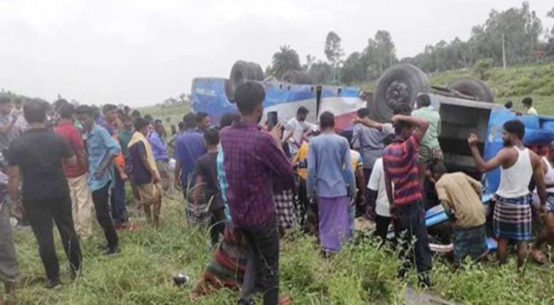
Shima Rani, a worker of a shrimp enclosure at the coastal village Sardar Para of Assasuni upazila in Satkhira district, used to walk two miles to fetch potable drinking water from a deep tube well even when she was carrying a baby.
“It was my daily routine to collect water from the deep tube well carrying a heavy pitcher, except for the rainy days. Sometimes I collected water twice a day when I was pregnant. It was an arduous task, but I had to do that as we didn’t have any other option to get drinkable water,” she said recalling the ordeals she went through many years.
Sabina Begum, a resident of Indira village under the Satkhira Sadar Upazila, had even more dire experience in collecting drinkable water.
“There’s a tube well around two miles away from my home, but it went out of order a long time ago. So, I had to go to another village commuting around 4 miles to fetch potable water for the six members of my family. I can’t describe how awful a job it was. I am still suffering from back pain caused by carrying the big pitcher,” he said.
Talking to the UNB correspondent during a recent visit to different water treatment plants installed by Qatar Charity ((QC) in four upazilas of Satkhira, the residents of the areas badly affected by contaminated-saline water, described how they went through sufferings to collect potable water, before the installation of the water plants by the QC.
According to the World Bank, there are 30 million people living in the coastal area of Bangladesh among which 2.5 million are facing an acute crisis
A study carried out by the United Nations Development Programme (UNDP), suggests 73 percent of the people living in five coastal upazilas of Satkhira have to drink saline water on a daily basis.
The study also depicted the hardships faced by the people of the coastal areas due to not having access to any other source of drinking water. Even during the dry season, the salinity level of tube-well water in some parts of Satkhira goes up to 6,600mg per litre.
The UNDP study also revealed that many people in the coastal areas consume water with very high levels of salinity, causing various health problems, while many people spend more than two hours per day fetching drinkable water from long distances.
According to the Satkhira District Department of Public Health Engineering, the salinity level is 4,400 milligrams per liter (mg/l) in most areas of the coastal district compared with the permitted threshold of 1,000 mg/l
The freshwater crisis has made people’s life miserable in the coastal district.
Health experts said consumption of saline-contaminated water or the use of saline water in daily household activities in coastal regions causes various health complications including, hypertension, skin diseases, cholera, diarrhea, anemia, premature deliveries, miscarriages, and other complexities related to women’s reproductive health.
Addressing the burning issue, Qatar Charity (QC), a leading Gulf-origin nongovernmental organization, has long been working for providing clean drinking water for the coastal residents by digging deep tub wells and installing water treatment plants.
Recently, QC has installed 410 water treatment plants in 5 districts of Bangladesh– Satkhira, Gopalganj, Jessore, Barguna, and Jhalakathi–benefiting more than 22,000 rural communities.
During the visit to the Satkhira, where QC has installed 268 water treatment plants, it was seen that local people were easily collecting potable water from thosewater plants in their respective areas. The beneficiaries expressed their happiness as they are getting pure water at their doorsteps.
Md Asaduzzaman Babu, an elected representative of local government administration, said, “It’sa great intervention by Qatar Charity. There is a huge crisis of potable water in this district as it’s a district along the Bay of Bengal. The surface water of these areas contains very high levels of salinity and unsafe levels of iron. In this context, the local people here are blessed by the QC’s initiative and they are now drinking fresh and safe water, getting rid of contaminated water.” Kaushik Roy, a government official of the Public Health Engineering Department, said, `The entire Satkhira district has become salinity prone due to its location close to the Bay of Bengal. Most of the water sources are contaminated in various ways. The rise in sea levels, storms, tidal surges, and flooding have affected drinking water sources in the region.”
besides, he said iron and arsenic levels are high in the water here. “As a result, people here are regularly affected by various diseases.” He thanked Qatar Charity for providing safe drinking water and ensuring the water quality of their plants as per the guidelines of the World Health Organization (WHO). “The government is also taking various projects to resolve the water crisis problems. But it is encouraging when the NGOs like QC comes forward to reduce the plights of the coastal people by setting up quality water treatment plants.”


